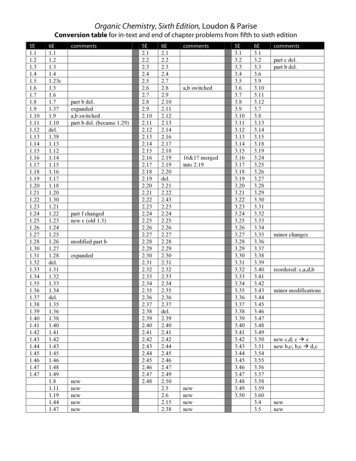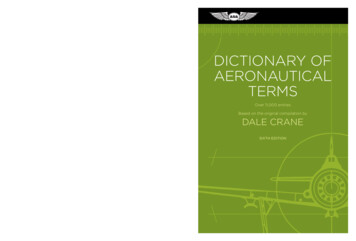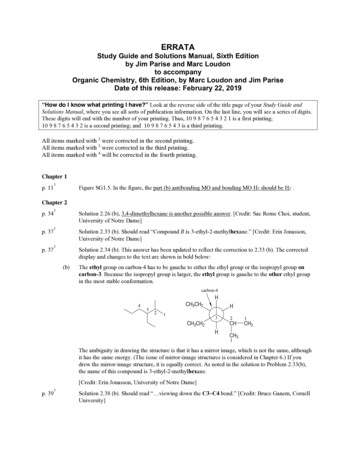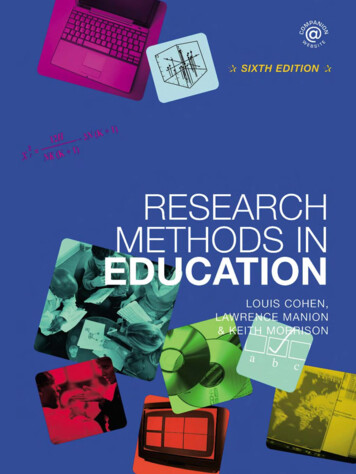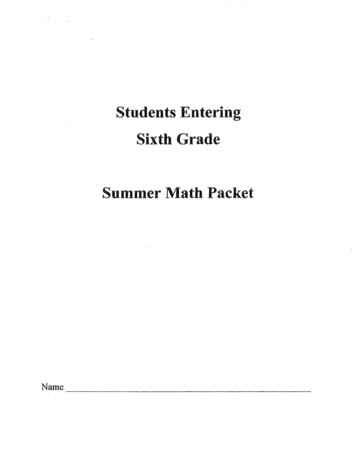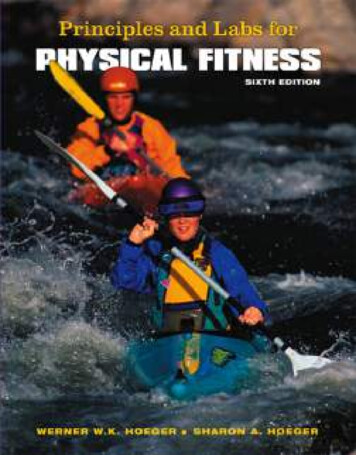
Transcription
Principles and Labs for Physical FitnessSIXTH EDITION
This page intentionally left blank
Principles and Labs for Physical FitnessSIXTH EDITIONWERNER W.K. HOEGERBoise State UniversitySHARON A. HOEGERFitness & Wellness, Inc.Australia Brazil Canada Mexico SingaporeSpain United Kingdom United States
Principles and Labs for Physical Fitness, Sixth EditionWerner W.K. Hoeger and Sharon A. HoegerExecutive Editor: Peter AdamsArt Director: John WalkerDevelopment Editor: Nedah RosePrint Buyer: Doreen SurukiAssistant Editor: Kate FrancoPermissions Editor: Bob KauserEditorial Assistant: Jean BlomoProduction/Composition: Graphic World Inc.Technology Project Manager: Ericka Yeoman-SalerText and Cover Designer: Ellen PettengellMarketing Manager: Jennifer SomervillePhoto Researcher: Terri WrightMarketing Assistant: Catie RonquilloCopy Editor: Carol LombardiMarketing Communications Manager: Jessica PerryIllustrator: Graphic World Inc.Project Manager, Editorial Production: Sandra CraigCover Image: Hughes Martin/CorbisCreative Director: Rob HugelPrinter: Courier Corporation/Kendallville 2008, 2006 Thomson Wadsworth, a part of TheThomson Corporation. Thomson, the Star logo, andWadsworth are trademarks used herein under license.ExamView and ExamView Pro are registered trademarksof FSCreations, Inc. Windows is a registered trademarkof the Microsoft Corporation used herein underlicense. Macintosh and Power Macintosh are registeredtrademarks of Apple Computer, Inc. Used herein underlicense.ALL RIGHTS RESERVED. No part of this work coveredby the copyright hereon may be reproduced or used inany form or by any means—graphic, electronic, ormechanical, including photocopying, recording,taping, Web distribution, information storage andretrieval systems, or in any other manner—without thewritten permission of the publisher.Printed in the United States of America1 2 3 4 5 6 7 11 10 09 08For more information about our products, contact us at:07Library of Congress Control Number: 2006940839ISBN-10: 0-495-11193-7ISBN-13: 978-0-495-11193-1Thomson Higher Education10 Davis DriveBelmont, CA 94002-3098USAThomson Learning Academic Resource Center1-800-423-0563For permission to use material from this text or product,submit a request online at http://www.thomsonrights.com.Any additonal questions about permissions can besubmitted by e-mail to thomsonrights@thomson.com.
Brief ContentsCHAPTER 1CHAPTER 8Why Physical Fitness? 1Muscular Flexibility 257Lab 1A Daily Physical Activity Log 27Lab 8A Muscular Flexibility Assessment 283Lab 1B Clearance for Exercise Participation 29Lab 8B Posture Evaluation 285Lab 1C Resting Heart Rate and Blood Pressure Assessment 31Lab 8C Flexibility Development and Low-BackConditioning 287CHAPTER 2Behavior Modification 33Lab 2A Controlling Your Physical Activity and Nutrition 55Lab 2B Behavior Modification Plan 57Lab 2C Setting SMART Goals 59CHAPTER 3Nutrition for Wellness 61Lab 3A Nutrient Analysis 103Lab 3B MyPyramid Record Form 107CHAPTER 4Body Composition 109CHAPTER 9Skill Fitness and FitnessProgramming 289Lab 9A Assessment of Skill-Related Componentsof Fitness 319Lab 9B Personal Fitness Plan 321CHAPTER 10Stress Management 325Lab 10A Life Experiences Survey 347Lab 10B Type A Personality and Hostility Assessment 351Lab 10C Stress Vulnerability Questionnaire 353Lab 4A Hydrostatic Weighing 125Lab 10D Goals and Time Management Skills 355Lab 4B Body Composition and Disease Risk 127Lab 10E Stress Management 359CHAPTER 5CHAPTER 11Weight Management 129A Healthy Lifestyle 361Lab 5A Daily Caloric Requirement and Exercise Plan 159Lab 11A Cardiovascular and Cancer Risk Management 399Lab 5B Calorie-Restricted Diet Plans 161Lab 11B Life Expectancy and Physiological Age Prediction 401Lab 5C Healthy Plan for Weight Maintenance or Gain 165Lab 11C Self-Evaluation and Future Goals 405Lab 5D Weight Management: Measuring Progress 167CHAPTER 6Cardiorespiratory Endurance 169Lab 6A Cardiorespiratory Endurance Assessment 197Lab 6B Caloric Expenditure and Exercise Heart Rate 199Lab 6C Exercise Readiness Questionnaire 203Lab 6D Cardiorespiratory Exercise Prescription 205APPENDIXA Nutritive Value of Selected Foods 409GLOSSARY 421ANSWERS TO ASSESS YOUR KNOWLEDGE 424INDEX 425CHAPTER 7Muscular Strength and Endurance 207Lab 7A Muscular Strength and Endurance Assessment 253Lab 7B Strength-Training Program 255v
This page intentionally left blank
ContentsCHAPTER 1Lab 1A Daily Physical Activity Log 27Why Physical Fitness? 1Lab 1B Clearance for Exercise Participation 29Life Expectancy Versus Healthy Life Expectancy 2Lifestyle as a Health Problem 3Physical Activity and Exercise Defined 4Lab 1C Resting Heart Rate and Blood Pressure Assessment 31CHAPTER 2Types of Physical Fitness 10Behavior Modification 33Benefits of Fitness 13Living in a Toxic Health and Fitness Environment 34A Healthy Lifestyle Challenge for the 21st Century 16Barriers to Change 38Guidelines for a Healthy Lifestyle: Using This Book 19Motivation and Locus of Control 40Exercise Safety 20Changing Behavior 41Assess Your Behavior 22Behavior Change Theories 41Assess Your Knowledge 23The Process of Change 44Media Menu 24Techniques of ChangeNotes 24Assess Your Behavior 51Suggested Readings 25Assess Your Knowledge 5148Media Menu 52Notes 52Suggested Readings 53Lab 2A Controlling Your Physical Activity and Nutrition 55Lab 2B Behavior Modification Plan 57Lab 2C Setting SMART Goals 59CHAPTER 3Nutrition for Wellness 61Nutrients 62Balancing the Diet 72Nutrient Analysis 74Nutrient Supplementation 83Energy Substrates for Physical Activity 90Nutrition for Athletes 91Bone Health and Osteoporosis 942005 Dietary Guidelines for Americans 97Proper Nutrition: A Lifetime Prescriptionfor Healthy Living 99Assess Your Behavior 100vii
viiiContentsAssess Your Knowledge 100CHAPTER 5Media Menu 101Weight Management 129Notes 102Suggested Readings 102Overweight Versus Obesity 131Lab 3A Nutrient Analysis 103Diet Crazes 133Lab 3B MyPyramid Record Form 107Eating Disorders 136The Physiology of Weight Loss 140CHAPTER 4Diet and Metabolism 143Body Composition 109Exercise: The Key to Weight Management 144Essential and Storage Fat 110Techniques to Assess Body Composition 111Behavior Modification and Adherence to a WeightManagement Program 153Determining Recommended Body Weight 119The Simple Truth 155Importance of Regular Body CompositionAssessment 121Assess Your Behavior 156Assess Your Behavior 122Media Menu 157Assess Your Knowledge 122Notes 157Media Menu 123Suggested Readings 158Notes 123Lab 5A Daily Caloric Requirement and Exercise Plan 159Suggested Readings 124Lab 5B Calorie-Restricted Diet Plans 161Lab 4A Hydrostatic Weighing 125Lab 5C Healthy Plan for Weight Maintenance or Gain 165Lab 4B Body Composition and Disease Risk 127Lab 5D Weight Management: Measuring Progress 167Losing Weight the Sound and Sensible Way 148Assess Your Knowledge 156CHAPTER 6Cardiorespiratory Endurance 169Basic Cardiorespiratory Physiology: A QuickSurvey 170Aerobic and Anaerobic Exercise 171Physical Fitness Assessment 173Assessment of Cardiorespiratory Endurance 174Tests to Estimate VO2max 176Principles of Cardiorespiratory ExercisePrescription 183Guidelines for Cardiorespiratory ExercisePrescription 184Fitness Benefits of Aerobic Activities 189Getting Started and Adhering to a Lifetime ExerciseProgram 191Assess Your Behavior 193Assess Your Knowledge 193Media Menu 194Notes 195Suggested Readings 195Lab 6A Cardiorespiratory Endurance Assessment 197Lab 6B Caloric Expenditure and Exercise Heart Rate 199Lab 6C Exercise Readiness Questionnaire 203Lab 6D Cardiorespiratory Exercise Prescription 205
ContentsCHAPTER 7CHAPTER 8Muscular Strengthand Endurance 207Muscular Flexibility 257Benefits of Strength Training 208Factors Affecting Flexibility 259Changes in Body Composition 210Assessment of Flexibility 259Assessment of Muscular Strength and Endurance 211Evaluating Body Posture 260Strength-Training Prescription 216Principles of Muscular Flexibility Prescription 265Strength GainsWhen to Stretch? 266222Benefits of Good Flexibility 258Strength-Training Exercises 223Flexibility Exercises 267Dietary Guidelines for Strength Development 223Preventing and Rehabilitating Low-Back Pain 267Core Strength Training 223Assess Your Behavior 272Exercise Safety Guidelines 225Assess Your Knowledge 273Setting Up Your Own Strength-Training Program 226Media Menu 274Assess Your Behavior 226Notes 274Assess Your Knowledge 226Suggested Readings 274Media Menu 227Flexibility Exercises 275Notes 227Exercises for the Prevention and Rehabilitationof Low-Back Pain 279Suggested Readings 228Strength-Training Exercises without Weights 231Strength-Training Exercises with Weights 236Stability Ball Exercises 249Lab 7A Muscular Strength and Endurance Assessment 253Lab 7B Strength-Training Program 255ixLab 8A Muscular Flexibility Assessment 283Lab 8B Posture Evaluation 285Lab 8C Flexibility Development and Low-BackConditioning 287CHAPTER 9Skill Fitness and FitnessProgramming 289Performance Tests for Skill-Related Fitness 291Team Sports 294Specific Exercise Considerations 296Exercise-Related Injuries 303Exercise and Aging 305Preparing for Sports Participation 307Personal Fitness Programming: An Example 310Leisure-Time Physical Activity 314You Can Get It Done 315Assess Your Behavior 315Assess Your Knowledge 315Media Menu 316Notes 316Suggested Readings 317Lab 9A Assessment of Skill-Related Components of Fitness 319Lab 9B Personal Fitness Plan 321
xContentsCHAPTER 10CHAPTER 11Stress Management 325A Healthy Lifestyle 361The Mind/Body Connection 326The Seven Dimensions of Wellness 362Stress 326Leading Causes of Death 363Stress Adaptation 328Diseases of the Cardiovascular System 364Perceptions and Health 329Cancer 377Sources of Stress 330Chronic Lower Respiratory Disease 383Behavior Patterns 330Accidents 383Vulnerability to Stress333Substance Abuse 384Time Management 333Sexually Transmitted Infections 387Coping with Stress 335An Educated Fitness/Wellness Consumer 390Which Technique Is Best? 343Life Expectancy and Physiological Age 393Assess Your Behavior 343Assess Your Knowledge 343The Fitness Experience and a Challengefor the Future 394Media Menu 344Assess Your Behavior 395Notes 345Assess Your Knowledge 395Suggested Readings 345Media Menu 396Lab 10A Life Experiences Survey 347Notes 397Lab 10B Type A Personality and Hostility Assessment 351Suggested Readings 398Lab 10C Stress Vulnerability Questionnaire 353Lab 11A Cardiovascular and Cancer Risk Management 399Lab 10D Goals and Time Management Skills 355Lab 11B Life Expectancy and Physiological Age Prediction 401Lab 10E Stress Management 359Lab 11C Self-Evaluation and Future Goals 405APPENDIXA Nutritive Value of Selected Foods 409GLOSSARY 421ANSWERS TO ASSESS YOUR KNOWLEDGE 424INDEX 425
PrefaceMost people go to college to learn how to make a living.Making a good living, however, won’t help unless people live an active lifestyle that will allow them to enjoywhat they have.This text will teach you how to improve your personal fitness, health, and wellness—from becomingmore physically active to losing weight, to gainingstrength, and to dropping bad habits and adoptingnew, healthier ones. We believe that you control manyof the factors that determine your health, and we’vewritten this book to show you how to take command ofyour own fitness and wellness and live a longer, healthier life.The Unwelcome TruthThe American way of life does not provide the humanbody with sufficient physical activity to maintain adequate health. Many present lifestyle patterns are such aserious threat to our health that they actually increasethe deterioration rate of the human body and oftenlead to premature illness and mortality.Research indicates that people who lead an activelifestyle live longer and enjoy a better quality of life.The U.S. Surgeon General has determined that lack ofphysical activity is detrimental to good health. As a result, the importance of sound fitness programs has assumed an entirely new dimension. The office of theSurgeon General identified physical fitness as a tophealth priority by stating that “The nation’s top healthgoals as we begin the new millennium are: exercise, increased consumption of fruits and vegetables, smokingcessation, and the practice of safe sex.” All four of thesefundamental healthy lifestyle factors are thoroughly addressed in this book.Because of the impressive scientific evidence supporting the benefits of physical activity, most people inthis country are aware that physical fitness promotes ahealthier, happier, and more productive life. Nevertheless, the vast majority do not enjoy a better quality of lifebecause they either are led astray by a multi-billion dollar “quick fix” industry or they simply do not know howto implement a sound physical activity program thatwill yield positive results. Only in a fitness course willpeople learn sound principles to create a healthylifestyle, including exercise prescriptions, that, if imple-mented, will teach them how to truly live life to itsfullest potential.Principles and Labs for Physical Fitness, sixth edition,contains 11 chapters and 33 laboratories (labs) thatserve as a guide to implement a comprehensive lifetimefitness program. Students are encouraged to adhere toa well-balanced diet and a healthy lifestyle to help themachieve wellness. To promote this, the book includes information on motivation and behavioral modificationtechniques that help the reader eliminate negative behaviors and implement a healthier way of life.The emphasis throughout the book is on teachingstudents how to take control of their own fitness andlifestyle habits so they can stay healthy and achieve thehighest potential for well-being.New in the Sixth EditionThis sixth edition of Principles and Labs for Physical Fitnesshas been revised and updated to conform to advancesand recommendations since the publication of the fifthedition. New contents are based on information reportedin literature and at professional health, physical education, exercise science, and sports medicine meetings.(The “running figure” iconnext to captions, headings, and text indicates the presence of data from theAmerican College of Sports Medicine [ACSM].)Significant changes in this new edition include additional Behavior Modification Planning (BMP) boxesin several chapters—each with a “Try It” activity to further personalize the lesson—a new “Assess Your Behavior” questionnaire at the end of each chapter to helpstudents reflect upon the chapter’s contents, four newlabs (1A, 2A, 3B, and 9B), several new graphs, and extensive new photography throughout the textbook. Individual chapter revisions include the following: New contents in Chapter 1 include information onthe prevalence of physical activity in the United States,ways to monitor daily physical activity, use of pedometers, benefits of physical activity based on diverse publichealth recommendations (30, 60, or 60 to 90 minutesper day), and physiological fitness and its components(according to ACSM’s Guidelines for Exercise Testing andPrescription, 2006). A new “Daily Physical Activity Log”lab also was added.
xiiPreface Information on behavior modification theories, including learning theories, problem solving, social cognitive theory, and relapse prevention, has been addedto Chapter 2. A new section on “Living in a ToxicHealth and Fitness Environment” and a new lab to helpstudents understand environmental influences on physical activity and nutrition further enhance an alreadyexcellent chapter on behavior modification. The Nutrition for Wellness chapter has been revisedto include information on the new MyPyramid guidelines. Trans fat intake guidelines and new sections onthe benefits of vitamin D and probiotics are included.The information on fiber, nutrient supplementation,and antioxidants also was updated. New Behavior Modification Planning boxes for healthy eating and selecting nutritious foods are provided. Chapter 4, Body Composition, incorporates extensivechanges, including standard error of estimates for thevarious body composition assessment techniques. Therole of body mass index (BMI) as the most widely usedtechnique to determine overweight and obesity in thegeneral population is discussed in greater detail. Further,the chapter emphasizes the importance of BMI in combination with waist circumference (WC) to help identifyindividuals with high abdominal visceral fat and increased risk for disease. The chapter labs were revised toconform to updated standards for BMI, WC, and an assessment of recommended body weight based on BMI. The Weight Management chapter includes updatedinformation on the health consequences of being overweight or obese, the role of the glycemic index of foodsin weight management, activity guidelines for weightgain prevention and weight loss maintenance, and newestimated energy requirement equations (EER) to determine daily caloric intake by the Dietary ReferenceIntake committee of the Institute of Medicine of theNational Academy of Sciences. Chapter 6, Cardiorespiratory Endurance, has beenrevised to conform to the current ACSM’s Guidelines forExercise Testing and Prescription (2006). In addition, theimportance of increasing daily physical activity as ameans to enhance health and quality of life is emphasized, accompanied by new Behavior Modification Planning boxes to increase daily activity and tips for inactiveindividuals to get started with exercise. The muscular strength prescription guidelines inChapter 7 have been updated according to the 2006ACSM’s Guidelines for Exercise Testing and Prescription. Adiscussion of the benefits of core strength training withexercise balls and a series of stability ball exercises havebeen added to the chapter, along with dietary guidelines for strength development. In Chapter 8, Muscular Flexibility, the benefits of goodposture were updated and the flexibility programmingguidelines were revised according to the 2006 ACSM’sGuidelines for Exercise Testing and Prescription. In Chapter 9, Skill Fitness and Fitness Programming,a new table on the contribution of selected activities toskill-related fitness has been added. Updates are alsoprovided for several of the questions related to specificexercise considerations, as well as to the section“Preparing for Sports Participation.” A new lab for students to demonstrate their competence in writing theirpersonal comprehensive fitness program has been included in the chapter. Chapter 10, Stress Management, now includes information on the power of the mind over the body, howemotions affect health and wellness, the explanatorystyle and resultant health outcomes, the effects of selfesteem on health, and a description of the fightingspirit. All statistics on the incidence and prevalence of cardiovascular disease, cancer, addictive behavior, and sexually transmitted infections have been updated inChapter 11. Included also are the 2006 Diet and LifestyleRecommendations by the American Heart Association todecrease cardiovascular disease risk, information ontrans fat and updates on dietary and lifestyle guidelinesto prevent and manage heart disease and prevent cancer, information on the role of physical activity in cancer prevention; and additional information on smokeless tobacco based on the 2006 U. S. Surgeon General’sreport on The Health Consequences of Involuntary Exposureto Tobacco Smoke. New Behavior Modification Planningboxes also were added to the chapter.AncillariesThomsonNOW Class-tested and student-praised,ThomsonNOW offers a variety of features that supportcourse objectives and interactive learning, includingpre- and post-tests and additional activities designed toget students involved in their learning progress and tobe better prepared for class participation, quizzes, andtests.Instructor’s Manual with Test Bank These two essential ancillaries are bound together for convenience.The Instructor’s Manual with Test Bank helps instructors plan and coordinate lectures by providing for eachchapter a detailed outline, a lab list, and ideas for incorporating the material into classroom activities anddiscussions. A full test bank containing approximately50 questions per chapter also is included.
PrefacePowerLecture for the Principles and Labs SeriesThis teaching tool contains lecture presentations thatfeature more than 100 PowerPoint slides, including atext outline, art, and resources such as the Instructor’sManual with Test Bank, all on one convenient CDROM. PowerLecture also includes: JoinIn on TurningPoint Enhance your students’ interaction with you, your lecture, and eachother using JoinIn content for Response Systemstailored to this text. Thomson’s exclusive agreementto offer TurningPoint software lets you pose bookspecific questions and display students’ answersseamlessly within the PowerPoint slides of your ownlecture, in conjunction with the “clicker” hardwareof your choice. ExamView Computerized Testing Create, deliver,and customize tests and study guides (both print andonline) in minutes with this easy-to-use assessmentand tutorial system. ExamView offers a Quick TestWizard that guides you step by step through theprocess of creating tests, while allowing you to see thetest you are creating on the screen exactly as it willprint or display online. You can build tests of up to250 questions and, using ExamView’s word processingcapabilities, you can enter an unlimited number ofquestions and can edit existing questions.Transparencies Approximately 100 color transparencyacetates of charts, tables, and illustrations from the textcan be used to enhance lectures.Personal Daily Log This log contains an exercise pyramid, ethnic food pyramid, time-management strategies,and goal-setting worksheets. It also includes cardiorespiratory endurance and strength training forms andmuch more.Behavior Change Workbook This workbook includesa brief discussion of current theories about making positive lifestyle changes, plus exercises to help studentsmake changes in everyday life.Diet Analysis 8.0 Diet Analysis , the market-leading diet assessment program used by colleges and universities, allows students to create personal profiles anddetermine the nutritional value of the diet. The program calculates nutrition intakes, goal percentages,and actual percentages of nutrients, vitamins, and minerals, customized to the student’s profile. Students canuse this tool to gain an understanding of the way nutrition relates to personal health goals. The software isavailable online or on a Windows/Mac CD-ROM.Testwell This online assessment tool allows students tocomplete a 100-question wellness inventory related toxiiithe dimensions of wellness. Students can evaluate theirnutrition, emotional health, spirituality, sexuality, physical health, self-care, safety, environmental health, occupational health, and intellectual health.Careers in Health, Physical Education, and SportThis essential manual for majors who are interested inpursuing a position in their chosen field guides themthrough the complicated process of picking the type ofcareer they want to pursue. The manual also providessuggestions on how to prepare for the working worldand offers information about different career paths, education requirements, and reasonable salary expectations. The supplement also describes the differences incredentials found in the field and testing requirementsfor certain professions.InfoTrac College Edition This extensive online librarygives professors and students access to the latest newsand research articles online—updated daily and spanning 20 years. Conveniently accessible from a personalcomputer or the library, InfoTrac College Edition opensthe door to the full extent of articles from hundreds ofscholarly and popular journals and publications.Wadsworth Video Library for Fitness, Wellness, andPersonal Health This comprehensive library of videosincludes such topics as weight control and fitness, AIDS,sexual communication, peer pressure, compulsive andaddictive behaviors, and the relationship between alcohol and violence. Available to qualified adopters. Pleaseconsult your local sales representative for details.Trigger Video Series Exclusive to Thomson Wadsworth,these videos are designed to promote classroom discussion on a variety of important topics related to physicalfitness and stress. Each 60-minute video contains five8–10 minute clips, followed by questions for discussionand material appropriate to the chapters in Hoeger andHoeger’s text. Available to qualified adopters. Pleaseconsult your local sales representative for details.Health and Wellness Resource Center at http://www.gale.com/HealthRC/index.htm Gale’s Health andWellness Resource Center is a new, comprehensive Website that provides easy-to-find answers to health questions.Walk4life Elite Model Pedometer This pedometertracks steps, elapsed time, distance, and caloriesburned. Whether used as a class activity or simply to encourage students to track their steps and walk towardbetter fitness, this is a valuable item for everyone.Website (http://thomsonedu.com/health) When youadopt Principles and Labs for Physical Fitness, sixth edition,you and your students will have access to a rich array ofteaching and learning resources that you won’t find any-
xivPrefacewhere else. Resources include self-quizzes, Web links, suggested online readings, and more.AcknowledgmentsThe authors wish to extend special gratitude to the following people, who provided feedback and reviewedthis and the previous edition of Principles and Labs forPhysical Fitness:Lewis Bowling, North Carolina Central UniversityMary Conway, Sierra CollegeJesse DeMello, Louisiana State University, ShreveportBritney Finley, University of Arkansas, Little RockSteve Gaskill, University of MontanaTabitha Halfmann, Southwest Texas State UniversityRebecca Hess, California University of PennsylvaniaJohn R. Hjelm, North Park UniversityLawrence C. Rohner, New Mexico State UniversityBarbara Rostick, Pennsylvania State UniversityJudy Sloan, Southern Adventist UniversitySusan M. Todd, Langara CollegeWe express gratitude to Amber Lee Fawson for herresearch and writing contributions to the new section on“Living in a Toxic Health and Fitness Environment” inChapter 2. We thank John Kelly, Jonathan Hoeger, Christine Popadics, Kristin Aldrich, Alia Loan, Josh Bean,Cherie Hoeger, Michelle Hoeger, Christopher Hoeger,Daniel Fawson, and Neely Falgout for their time and assistance with new photography in this edition.Brief Author BiographiesWerner W.K. Hoeger is the most successful fitness andwellness college textbook author. Dr. Hoeger is a fulltime professor and director of the Human Performance Laboratory at Boise State University. He completed his undergraduate and master’s degrees inphysical education at the age of 20 and received hisdoctorate degree with an emphasis in exercise physiology at the age of 24. Dr. Werner Hoeger is a fellow ofthe American College of Sports Medicine. He was recognized as the Outstanding Alumnus from the Collegeof Health and Human Performance at Brigham YoungUniversity in 2002 and was the first recipient of thePresidential Award for Research and Scholarship in theCollege of Education at Boise State University in 2004.Dr. Hoeger uses his knowledge and personal experiences to write engaging, informative books that thoroughly address today’s fitness and wellness issues in aformat accessible to students. He has written severaltextbooks for Thomson Wadsworth, including LifetimePhysical Fitness and Wellness, ninth edition; Fitness andWellness, seventh edition; Principles and Labs for PhysicalFitness, sixth edition; Wellness: Guidelines for a HealthyLifestyle, fourth edition; and Water Aerobics for Fitness andWellness, third edition (with Terry-Ann Spitzer Gibson).He was the first author to write a college fitness textbook that incorporated the “wellness” concept. In 1986,with the release of the first edition of Lifetime Physical Fitness and Wellness, he introduced the principle that totruly improve fitness, health, and quality of life andachieve wellness, a person needed to go beyond the basic health-related components of physical fitness. Hiswork was so well received that almost every fitness authorimmediately followed his lead in their own publications.As an innovator in the field, Dr. Hoeger has developed many fitness and wellness assessment tools, including fitness tests such as the modified sit-and-reach,total body rotation, shoulder rotation, muscular endurance, muscular strength and endurance, and sodapop coordination tests. Proving that he “practices whathe preaches,” at 48, he was the oldest male competitorin the 2002 Winter Olympics in Salt Lake City, Utah. Heraced in the sport of luge along with his then-17-yearold son Christopher. It was the first time in WinterOlympics history that father and son competed in thesame event. In 2006, at the age of 52, he was the oldestcompetitor at the Winter Olympics in Turin, Italy.Sharon A. Hoeger is vice-president of Fitness & Wellness, Inc., of Boise, Idaho. Sharon received her degree incomputer science from Brigham Young University. She isthe developer of innovative fitness and wellness softwareand is a co-author of five of the seven fitness and wellnesstitles. Husband and wife have been jogging and strengthtraining together for more than 30 years. They are theproud parents of five children, all of whom are involvedin sports and lifetime fitness activities. Their motto:“Families that exercise together, stay together.”
Why Physical Fitness?CHAPTER 1OBJECTIVES Identify the major health problemsin the United States. Describe the difference betweenphysical activity and exercise. Explain the relationships betweenan active lifestyle and health andlongevity. Define physical fitness and list thecomponents of health-related andskill-related fitness. Differentiate health fitness standards from physical fitnessstandards. Point out the benefits and the significance of part
SIXTH EDITION Principles and Labs for Physical Fitness WERNER W.K. HOEGER Boise State University SHARON A. HOEGER Fitness & Wellness, Inc. Australia Brazil Canada

